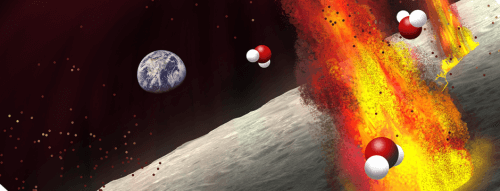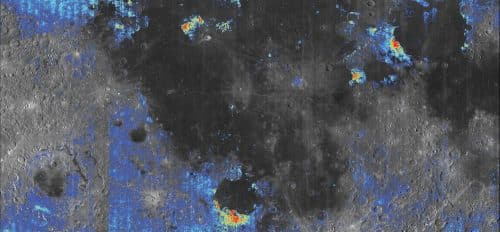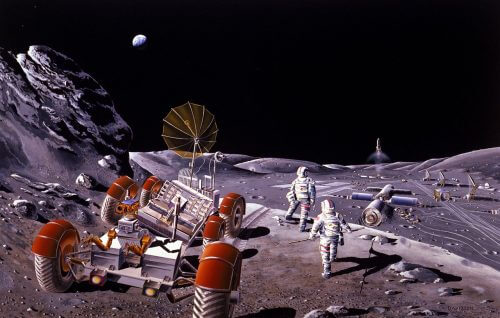Researchers based on information from the Indian probe Chandrayaan 1, discovered a relatively high amount of water in volcanic sediments on the moon, indicating that its depths contain much more water than previously thought. Will the new discovery help future manned missions to the moon?

In the past it was common to think that the moon was almost completely dry, but in recent years this picture is changing. A few years ago researchers managed to prove Large amounts of water ice hide in craters at the poles of the moon. Now, new research finds that water is not only at the poles - but also deep underground.
The new study, by researchers from Brown University in the United States, found that ancient volcanic deposits around the moon contain a much higher amount of water than their surroundings. The researchers hypothesize that the water is trapped inside tiny glass spheres, formed during volcanic eruptions from the depths of the moon.
In 2008, researchers were able to find water in these glass spheres, which were found in returned samples by the astronauts of the Apollo 15 and 17 missions from the 70s. Another study conducted in 2011, revealed that crystalline structures within these spherules contain an amount of water identical to that found in certain basalt rocks on Earth.
So far, researchers have not been able to determine whether the samples returned from the Apollo missions represent other volcanic deposits around the moon, or whether they are just an anomaly, and therefore could not determine whether the interior of the moon also contains as high a quantity of water as these samples.
The new study, however, was based on global observations by the Indian probe Chandrian 1, orbited the moon and operated between 2008 and 2009. The information gathered by the probe allowed the researchers to show that the samples from the Apollo missions are not unusual at all.
"The key question is whether these Apollo samples represent the bulk of conditions in the lunar interior, or alternatively represent unusual or perhaps anomalous water-rich regions in the mantle, which is otherwise 'dry,'" said Ralph Milliken, associate professor at Brown University and lead author of the study. which was published in the journal Nature Geoscience.
"By looking at the orbital data, we can examine large pyroclastic [rock of volcanic origin] deposits on the Moon that have never been sampled by the Apollo or Luna missions. The fact that almost all of them include signatures of water indicates that the Apollo samples are not an anomaly, so it is possible that most of the interior of the moon is wet."

The researchers used the data collected "The lunar mineralogy map", a NASA instrument attached to Chandrayaan 1, which measured the spectrum of radiation (the wavelengths of which radiation is composed) that was reflected from the lunar surface. To locate the water in those volcanic deposits, the researchers looked for specific wavelengths in the spectrum, which are absorbed or reflected by water and confirm their existence.
Previous analyzes of the data from Chandrayaan 1 failed to detect water, because its "signature" in the spectrum was obscured by the thermal radiation emitted by the ground, which heats up greatly during the lunar day. To remove the effect of the thermal radiation, the researchers used a computer model based on the lunar samples brought back from the Apollo missions.
"The distribution of these water-rich areas is the key," Milliken said. "They are scattered throughout the moon, which tells us that the water found in the Apollo samples is not a one-time event. Lunar pyroclastic deposits appear to be universally rich in water, suggesting that this is also true of the Moon's mantle."
How did water get to the moon?
The new discovery raises an important question about the history of the moon, because water plays a significant part in the story of its formation.
The accepted hypothesis among researchers is that the Moon was formed by a massive collision of the Earth with a body the size of Mars. The intense heat generated by the collision, the researchers thought, at least until now, should not have allowed the water to survive.
The researchers have two possible answers to the mystery - either in some unclear way water managed to survive the extreme heat, or they were brought to the moon afterwards, before it had time to cool and solidify, by water-rich asteroids or comets.
"The exact source of the water in the lunar interior is still a big question," said Shuai Li, co-author of the paper, which is part of his doctoral thesis.
Will the new discovery help to carry out manned missions on the moon?
Several years ago, another important discovery related to water on the moon was made - the discovery of ice deposits in craters at its poles. The ice in these craters survives due to their unique location at the poles, which allows them to hide from sunlight permanently.
Those who support a return to the moon claim that it will be possible to utilize the water at the poles for manned missions. Among other things, it will be possible to use water for drinking, production of oxygen for breathing, as well as for the production of hydrogen-oxygen fuel for propulsion of space vehicles. However, this water is frozen and trapped at the bottom of the dark craters, and it will be very difficult to reach it and dig it out. The new discovery may show that water can also be found in other, more accessible areas on the moon.

At the same time, the amount of water found in the volcanic sediments is quite small - the water made up only 0.05% of the weight of the glass spherules found in the Apollo samples. As a counterweight to this, it is possible that the large size of the volcanic deposits will contain water in sufficient quantity to be utilized for future missions.
"Other studies have indicated the presence of water ice in shaded areas at the lunar poles, but the pyroclastic deposits are in areas that are much easier to reach," the researcher told me. "Anything that helps prevent future lunar explorers from bringing lots of water from Earth is a big step forward, and our results point to a new alternative."
to the notice of the researchers
For an article in the journal Nature Geoscience
See more on the subject on the science website:

12 תגובות
Sorry for the flooding, I wanted to check why my message was blocked...
Because our decisions are physical and mechanistic.
You really have no control.
The important question is what is the truth, not what seems more logical or nice to you.
The important question is what is the truth, not what seems more logical or nice to you. Because our decisions are physical and mechanistic so you really have no control.
The important question is what is the truth, not what seems more logical or nice to you. Because our decisions are physical and mechanistic then you really have no control over the crimes you might commit.
The important question is what is the truth, not what seems more logical or nice to you. Because our decisions are physical and mechanistic, so you really have no control over crimes you may commit, but in the event that you claim this in court, then he will also be able to answer you that he also has no control over the decision to punish you, and this is also a result of mechanistic physical thinking.
You're a liar to the extent that we won't talk about a charlatan. What do you get out of lying and whining for another few years, the ball is about to freeze? Read this and cry Elk warming try ice age cooling is coming https://www.youtube.com/watch?v=4GtYMTpNUoQ
my father
Leave the dinosaurs. May they rest in peace. They are part of Jules Warren's story, after all you need a little plot and a little adventure. The book is not a scientific report. What is important here is the very idea that Jules Warren put forward here.
If the estimated amount of water in the lunar soil is at a concentration of 0.05%, then 1 liters of soil are needed to produce 20 liter of water.
It is not (and maybe actually is) in the sky.
Let's assume that the production efficiency is not 100%, but only 50%, so for each liter of water, about 40 liters of land will be required. still reasonable.
At the same time, it will be necessary to develop a technology that will preserve and purify almost 100% of the water, for reuse.
In short, there will be many facilities there: for production, purification, water conservation.
And what will cool these facilities?
There is no air there. Fans cannot cool without gas flow.
It does not seem to me that cooling by heat radiation will be enough and it will be necessary to cool with water that will be cooled by flowing through the dark and cold side of the moon.
In addition, wherever these facilities are placed, night will prevail on the moon for about half of each month.
Assuming that the facilities will be powered by solar energy, then during the night (half a month), they will not work.
Because of this, if they want to have a permanent, ongoing activity there, 7/24 (except for Shabbat, holidays, Yom Kippur and May 1st of course), it will be necessary to install several stations for: water production\conservation\purification around the moon.
In short, the moon will be one complete geographic-economic-commercial-research unit.
This is where politics comes into play (!!)
The activity on the moon will have to be conducted only in accordance with an international convention, which will bind all countries and nations of the world. Maybe something like a UN agency. We will call it the "UN Lunar Agency".
And of course, every year, at the annual meeting of the "UN Lunar Agency", Jibril Rajov's proposal to condemn Israel because of Al-Aqsa will be accepted.
I read your article
The North Pole is floating because of the North Sea and there cannot be an opening to the land from there..
Perhaps the Eskimos mean an area where there is air trapped under the polar ice cap.
It is known that there are aquifers, also in Israel, and in Hala there may be an underground space with an aquifer and air above it. But it's a bit far from Jules Warren's description of a world complete with dinosaurs...
Spacecraft findings have shown that Jupiter's moon Europa has an underground ocean, Saturn's moon Enceladus has an underground ocean, and there are hints that Saturn's moon Dion also has an underground ocean. Now we are talking about the moon. So maybe Earth has an underground ocean too. Following revelations about such a possibility, I prepared an article discussing the implications arising from it http://www.tapuz.co.il/blogs/viewentry/7400291